2016 KIA PICANTO tow
[x] Cancel search: towPage 376 of 488
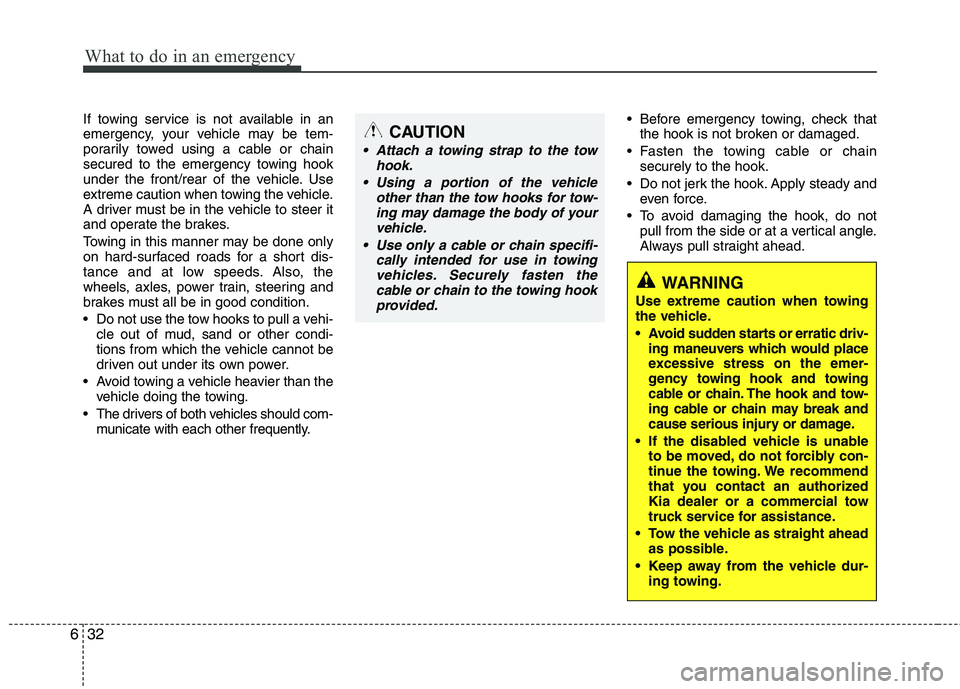
What to do in an emergency
32
6
If towing service is not available in an
emergency, your vehicle may be tem-
porarily towed using a cable or chain
secured to the emergency towing hook
under the front/rear of the vehicle. Use
extreme caution when towing the vehicle.
A driver must be in the vehicle to steer it
and operate the brakes.
Towing in this manner may be done only
on hard-surfaced roads for a short dis-
tance and at low speeds. Also, the
wheels, axles, power train, steering and
brakes must all be in good condition.
Do not use the tow hooks to pull a vehi-
cle out of mud, sand or other condi-
tions from which the vehicle cannot be
driven out under its own power.
Avoid towing a vehicle heavier than the vehicle doing the towing.
The drivers of both vehicles should com- municate with each other frequently. Before emergency towing, check that
the hook is not broken or damaged.
Fasten the towing cable or chain securely to the hook.
Do not jerk the hook. Apply steady and even force.
To avoid damaging the hook, do not pull from the side or at a vertical angle.
Always pull straight ahead.CAUTION
Attach a towing strap to the tow
hook.
Using a portion of the vehicle other than the tow hooks for tow-ing may damage the body of yourvehicle.
Use only a cable or chain specifi- cally intended for use in towingvehicles. Securely fasten thecable or chain to the towing hook provided.
WARNING
Use extreme caution when towing
the vehicle.
Avoid sudden starts or erratic driv- ing maneuvers which would place
excessive stress on the emer-
gency towing hook and towing
cable or chain. The hook and tow-
ing cable or chain may break and
cause serious injury or damage.
If the disabled vehicle is unable to be moved, do not forcibly con-
tinue the towing. We recommend
that you contact an authorized
Kia dealer or a commercial tow
truck service for assistance.
Tow the vehicle as straight ahead as possible.
Keep away from the vehicle dur- ing towing.
Page 377 of 488
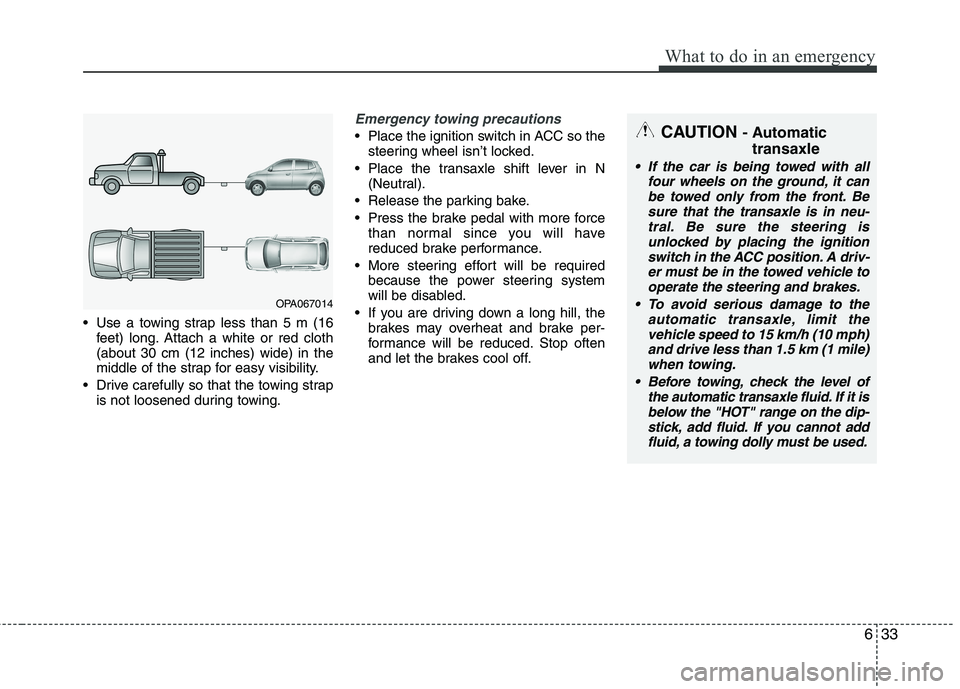
633
What to do in an emergency
Use a towing strap less than 5 m (16feet) long. Attach a white or red cloth (about 30 cm (12 inches) wide) in the
middle of the strap for easy visibility.
Drive carefully so that the towing strap is not loosened during towing.
Emergency towing precautions
Place the ignition switch in ACC so thesteering wheel isn’t locked.
Place the transaxle shift lever in N (Neutral).
Release the parking bake.
Press the brake pedal with more force than normal since you will have
reduced brake performance.
More steering effort will be required because the power steering system
will be disabled.
If you are driving down a long hill, the brakes may overheat and brake per-
formance will be reduced. Stop often
and let the brakes cool off.CAUTION - Automatic
transaxle
If the car is being towed with all four wheels on the ground, it can
be towed only from the front. Besure that the transaxle is in neu-tral. Be sure the steering isunlocked by placing the ignition
switch in the ACC position. A driv-er must be in the towed vehicle to operate the steering and brakes.
To avoid serious damage to the automatic transaxle, limit thevehicle speed to 15 km/h (10 mph) and drive less than 1.5 km (1 mile)when towing.
Before towing, check the level of the automatic transaxle fluid. If it isbelow the "HOT" range on the dip-stick, add fluid. If you cannot add fluid, a towing dolly must be used.
OPA067014
Page 378 of 488
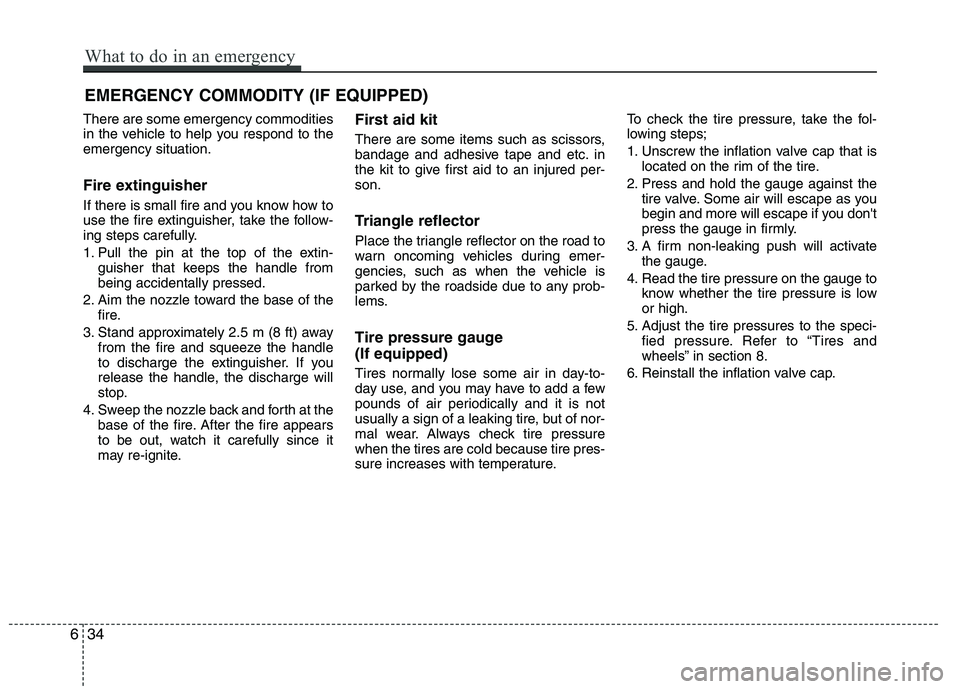
EMERGENCY COMMODITY (IF EQUIPPED)
There are some emergency commodities
in the vehicle to help you respond to theemergency situation.
Fire extinguisher
If there is small fire and you know how to
use the fire extinguisher, take the follow-
ing steps carefully.
1. Pull the pin at the top of the extin- guisher that keeps the handle from being accidentally pressed.
2. Aim the nozzle toward the base of the fire.
3. Stand approximately 2.5 m (8 ft) away from the fire and squeeze the handle
to discharge the extinguisher. If you
release the handle, the discharge will
stop.
4. Sweep the nozzle back and forth at the base of the fire. After the fire appears
to be out, watch it carefully since it
may re-ignite. First aid kit
There are some items such as scissors,
bandage and adhesive tape and etc. in
the kit to give first aid to an injured per-son.
Triangle reflector
Place the triangle reflector on the road to
warn oncoming vehicles during emer-
gencies, such as when the vehicle is
parked by the roadside due to any prob-
lems.
Tire pressure gauge (If equipped)
Tires normally lose some air in day-to-
day use, and you may have to add a few
pounds of air periodically and it is not
usually a sign of a leaking tire, but of nor-
mal wear. Always check tire pressurewhen the tires are cold because tire pres-
sure increases with temperature. To check the tire pressure, take the fol-
lowing steps;
1. Unscrew the inflation valve cap that is
located on the rim of the tire.
2. Press and hold the gauge against the tire valve. Some air will escape as you
begin and more will escape if you don't
press the gauge in firmly.
3. A firm non-leaking push will activate the gauge.
4. Read the tire pressure on the gauge to know whether the tire pressure is lowor high.
5. Adjust the tire pressures to the speci- fied pressure. Refer to “Tires and
wheels” in section 8.
6. Reinstall the inflation valve cap.
634
What to do in an emergency
Page 398 of 488
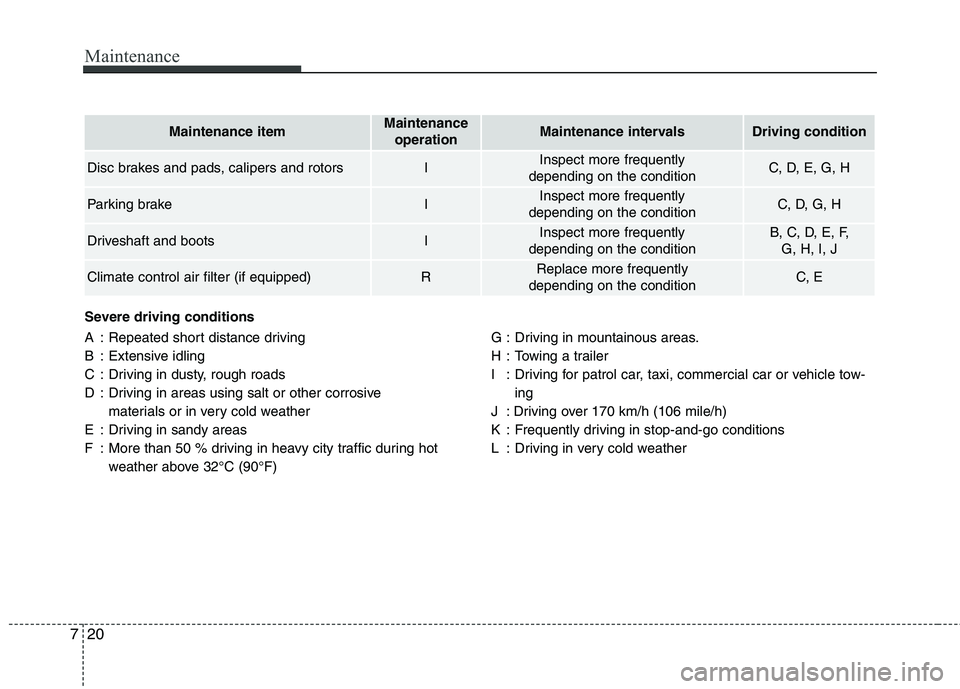
Maintenance
20
7
Severe driving conditions
A : Repeated short distance driving
B : Extensive idling
C : Driving in dusty, rough roads
D : Driving in areas using salt or other corrosive
materials or in very cold weather
E : Driving in sandy areas
F : More than 50 % driving in heavy city traffic during hot weather above 32°C (90°F) G : Driving in mountainous areas.
H : Towing a trailer
I : Driving for patrol car, taxi, commercial car or vehicle tow-
ing
J : Driving over 170 km/h (106 mile/h)
K : Frequently driving in stop-and-go conditions
L : Driving in very cold weather
Maintenance itemMaintenance operationMaintenance intervalsDriving condition
Disc brakes and pads, calipers and rotorsIInspect more frequently
depending on the conditionC, D, E, G, H
Parking brakeIInspect more frequently
depending on the conditionC, D, G, H
Driveshaft and bootsIInspect more frequently
depending on the conditionB, C, D, E, F, G, H, I, J
Climate control air filter (if equipped)RReplace more frequently
depending on the conditionC, E
Page 404 of 488
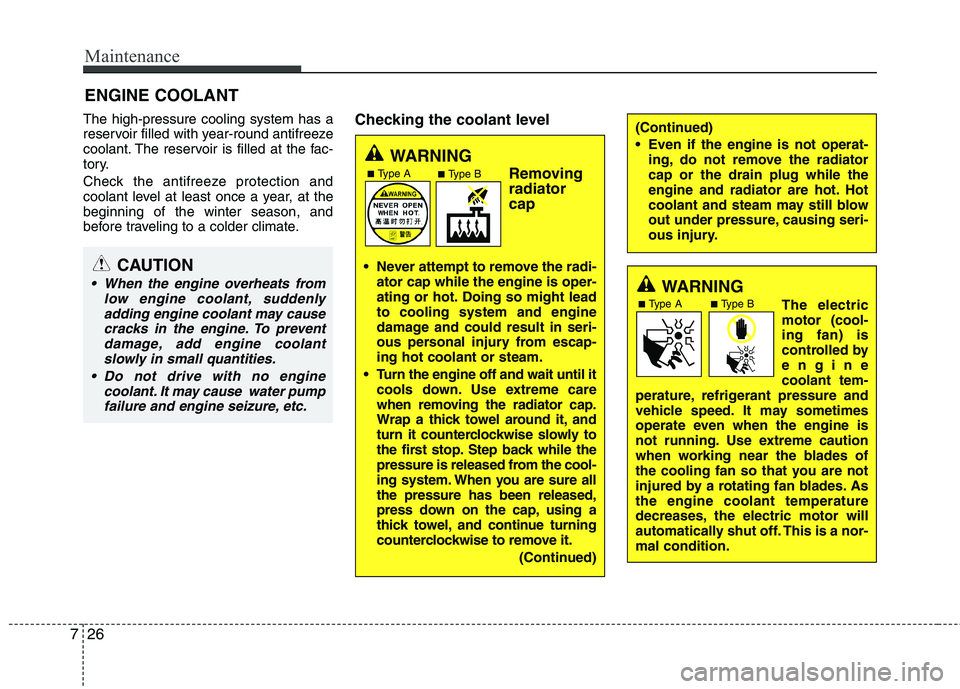
Maintenance
26
7
ENGINE COOLANT
The high-pressure cooling system has a
reservoir filled with year-round antifreeze
coolant. The reservoir is filled at the fac-
tory.
Check the antifreeze protection and
coolant level at least once a year, at thebeginning of the winter season, and
before traveling to a colder climate. Checking the coolant level
WARNING
Removingradiator cap
Never attempt to remove the radi- ator cap while the engine is oper-
ating or hot. Doing so might leadto cooling system and engine
damage and could result in seri-
ous personal injury from escap-ing hot coolant or steam.
Turn the engine off and wait until it cools down. Use extreme care
when removing the radiator cap.
Wrap a thick towel around it, and
turn it counterclockwise slowly to
the first stop. Step back while the
pressure is released from the cool-
ing system. When you are sure allthe pressure has been released,
press down on the cap, using a
thick towel, and continue turning
counterclockwise to remove it.
(Continued)
(Continued)
Even if the engine is not operat-ing, do not remove the radiator cap or the drain plug while the
engine and radiator are hot. Hot
coolant and steam may still blow
out under pressure, causing seri-
ous injury.
WARNING
The electric motor (cool-ing fan) is
controlled byenginecoolant tem-
perature, refrigerant pressure and
vehicle speed. It may sometimes
operate even when the engine is
not running. Use extreme caution
when working near the blades of
the cooling fan so that you are not
injured by a rotating fan blades. Asthe engine coolant temperature
decreases, the electric motor will
automatically shut off. This is a nor-mal condition.
CAUTION
When the engine overheats from
low engine coolant, suddenly
adding engine coolant may causecracks in the engine. To preventdamage, add engine coolant slowly in small quantities.
Do not drive with no engine coolant. It may cause water pumpfailure and engine seizure, etc.
■ Type B■Type A
■ Type B■Type A
Page 483 of 488

Index
4
I
Driving at night ..............................................................5-55
Driving in flooded areas ................................................5-57
Driving in the rain ..........................................................5-56
Economical operation ....................................................5-52
Electronic power steering ..............................................4-35
Electronic stability program (ESP) ................................5-32
Emergency commodity ..................................................6-34
Emergency starting ..........................................................6-5
Jump starting ................................................................6-5
Push starting ..................................................................6-7
Emergency stop signal (ESS) ........................................5-37
Emergency towing ..........................................................6-31
Emergency while driving ..................................................6-3
Emission control system ................................................7-82 Crankcase emission control system ............................7-82
Evaporative emission control system..........................7-82
Exhaust emission control system ................................7-83
Engine compartment..................................................2-4, 7-2
Engine coolant ................................................................7-26Engine coolant temperature gauge..................................4-46
Engine number ..................................................................8-7
Engine oil ........................................................................7-24
Engine overheats ..............................................................6-8
Engine start/stop button ....................................................5-6
Engine will not start..........................................................6-4 Evaporative emission control system..............................7-82
Exhaust emission control system ....................................7-83
Explanation of scheduled maintenance items ................7-21
Exterior care....................................................................7-76
Flat tire ..............................................................................6-9
Changing tires ............................................................6-10
Jack and tools ................................................................6-9
Removing and storing the spare tire ..........................6-10
Fluid Automatic transaxle fluid............................................7-30
Brake fluid ..................................................................7-29
Washer fluid ................................................................7-32
Folding the rear seat........................................................3-12
Front seat adjustment - manual ........................................3-5
Fuel filler lid ..................................................................4-28
Fuel gauge ......................................................................4-44
Fuel requirements ............................................................1-3
Fuses ..............................................................................7-54 Fuse/relay panel description ......................................7-58
Instrument panel fuse ..................................................7-55
Memory fuse ..............................................................7-56
Multi fuse ..........................................................................-
F
E
Page 487 of 488

Index
8
I
Special driving conditions ..............................................5-54
Driving at night ..........................................................5-55
Driving in flooded areas ............................................5-57
Driving in the rain ......................................................5-56
Hazardous driving conditions ....................................5-54
Highway driving ........................................................5-57
Rocking the vehicle ....................................................5-54
Smooth cornering ........................................................5-55
Speed limit control system ............................................5-49
Speedometer....................................................................4-45
Starting difficulties, see engine will not start ..................6-4
Starting the engine ............................................................5-9
Steering wheel ................................................................4-35 Electronic power steering ..........................................4-35
Heated steering wheel ................................................4-36
Horn ............................................................................4-37
Tilt steering ................................................................4-35
Steering wheel audio control ........................................4-120
Storage compartment ....................................................4-110 Glove box ..................................................................4-110
Sunglass holder ........................................................4-111
Sunglass holder ............................................................4-111
Sunroof............................................................................4-31
Sunvisor ........................................................................4-114 Tachometer ......................................................................4-45
Tailgate ............................................................................4-19
Tilt steering ....................................................................4-36
Tire Mobility Kit (TMK) ................................................6-19
Tire Pressure Monitoring System (TPMS) ....................6-25
Tire specification and pressure label ................................8-7
Tires and wheels ......................................................7-44, 8-3
Checking tire inflation pressure ..................................7-45
Low aspect ratio tire ..................................................7-53
Recommended cold tire inflation pressures................7-44
Tire care ......................................................................7-44
Tire maintenance ........................................................7-49
Tire replacement ........................................................7-47
Tire rotation ................................................................7-47
Tire sidewall labeling ..................................................7-50
Tire traction ................................................................7-49
Wheel alignment and tire balance ..............................7-47
Wheel replacement ....................................................7-49
Towing ............................................................................6-30 Emergency towing ......................................................6-31
Transaxle Automatic transaxle ....................................................5-21
Manual transaxle ........................................................5-18
Transaxle shift indicator ................................................4-48
Trip computer..................................................................4-50T